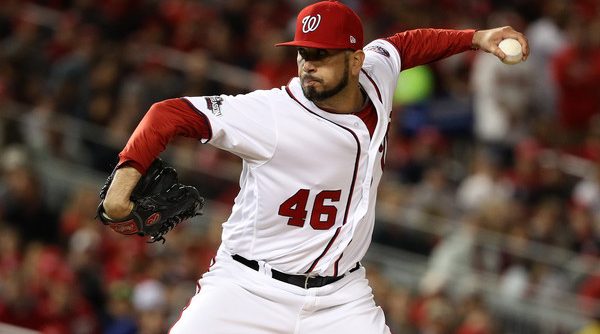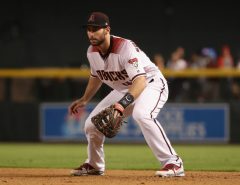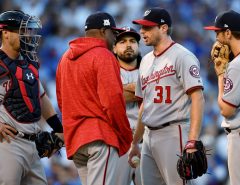If you’re reading this, you’re surely aware that the Nationals’ bullpen has been very bad this year. To put it empirically, Nats relievers have allowed 18 runs in 20 1/3 innings this year, or a 7.98 ERA. That’s awful!
If you were an optimist, you might say this is good news! The bullpen is pitching miles worse than even the worst-case scenario for the rest of the season, and the Nats are still just 3-3. The offense is averaging a solid 4.5 runs per game, and the starters not named Guthrie have been stellar. While that all may be true, it’s also true that this means the relievers might be pretty bad the rest of the season too. Let’s look at how each reliever has performed thus far this season, and see what their prognosis is for the rest of the season.
Tier 1: Relievers with an ERA Under 8.00
Joe Blanton
Blanton has been good! 4.2 IP, 4 H, 1 ER, 0 BB, 4 K. The lone free-agent signing to the bullpen has done a fine job so far, and all indications are that he should continue to do so. I’ll save my ink for the relievers I’m more worried about.
Koda Glover
Glover’s stats so far paint an odd picture: 2.2 IP, 3 H, 1 ER, 1 BB, 0 K. He looked good in his first two outings of the season before he lost every ounce of command in serving up a walk-off win to the Phillies Sunday. The zero strikeouts is surprising for a guy with Glover’s high-octane stuff, but he’s kept hitters uncomfortable: His three hits allowed are an infield single and a pair of bloops.
As his rocky MLB cameo last season suggested (injury aside), Glover may still have some adjusting to do. But with his stuff and mentality, he should be a reliable presence in the back of the bullpen soon — even though he might not be there quite yet.
Tier 2: Relievers with an ERA Over 8.00
Blake Treinen
Treinen has the opposite of Glover’s problem. He’s struck out six of the 16 batters he’s faced so far this season, or an impressive 37.5 percent. But he’s been touched up a bit anyway: five hits (including a homer), one walk, and three runs in just 3 1/3 innings. However, a closer look reveals cause for optimism.
One walk is a fine number for Treinen, though his control issues have gotten him in a few other deep counts. The one homer should not be any cause for concern: Treinen has done a spectacular job of limiting home runs through his career, with a career 0.52 HR/9 and 0.67 HR/9 last year amid MLB’s league-wide homer spike. I don’t expect the gopher ball trend to continue. The other four hits he’s allowed have been singles, and he’s only recorded four outs on balls in play so far. That .500 BABIP is silly of course, and a few more hits sneaking in is hardly unexpected for a groundballer like Treinen.
Treinen is as known of a commodity as anyone in the bullpen; I don’t think he’s suddenly become homer-prone or hittable. As much as anyone, he is the victim of a small sample size. He’ll be just fine. Whether he’s the best fit to close is another question.
Sammy Solis
Solis has simply seemed out of whack in his few outings so far. After a clean inning on Opening Day, Solis entered in a save situation three days later and seemed a little too excited. He was sitting 97 with little command at the beginning of his outing before settling to his usual velocity of 93-95 a little later on. He left a runner on for Treinen, who allowed the run to score. The next day, Solis was down to 91-92 and served up a two-run shot while only getting one out.
Solis posted a scoreless inning Sunday, which one hopes is a return to normalcy. He has given himself a bit of a reputation for wildness after walking over a batter every two innings last season, though he never had high walk numbers in the minors. But it’s important to remember that Solis is a converted starter who has only been coming out of the bullpen since 2015. As his attempted save shows, he might get a bit too excited for certain situations. He’s shown that he’s capable of being a good MLB reliever, and hopefully consistency will come with time.
Oliver Perez
Perez has appeared in just two games so far, so his numbers are among the hardest to judge. He threw three pitches in his first outing, retiring the one lefty he was asked to. He threw 38 in his next, getting touched up for three runs over two innings in the 17-3 blowout loss against the Phillies. Unsurprisingly, it was the righties that did the most damage against him in Philadelphia, going 3-for-6 with a triple and a homer. There’s no major surprise here: Perez fits best as a lefty-only guy. Try not to worry about him too much.
Enny Romero
Despite his shiny spring and World Baseball Classic, Romero has yet to have a good outing as a Nat. He allowed three hits and a run in his first, failed to retire a batter in his second, and gave up three runs in his third. He is one of three or so lefties on Earth who can touch 100 mph, but that doesn’t mean a lot when you can’t command it.
The conclusions from Romero’s raw numbers are pretty clear: He’s getting hit A LOT. He’s allowed eight hits in just 2 1/3 innings for a BABIP of .583. He has three strikeouts and one walk, plus one home run allowed. But for him, the key all along has been whether or not he will throw strikes. And there’s pretty convincing evidence he’s started doing so: This season, 56.1 percent of the pitches Romero has thrown have been in the strike zone. Last season, that number was 47.5 percent.
But there’s a lot more to that story. Last season, Kenley Jansen led all relievers in Zone% at 53.2 percent. And clearly throwing more strikes has not been working for Romero so far. If he’s just a different type of bad, then he won’t be long for this roster. But if that increase in Zone% shows that he has made some changes in his ability to locate, then he might be able to find a percentage of strikes that works for him. Only time will tell.
Shawn Kelley
Poor Shawn finds himself at the bottom of this list with a 13.50 ERA after being one of baseball’s best relievers last year. The source of those ugly numbers is the two homers he’s served up (though they’re the only hits he’s allowed!), in addition to his two walks and four strikeouts through two innings. But there’s more than meets the eye here, as pointed out by The Nationals Review’s Charlie Fliegel on Twitter.
Uh guys… I think I shared some of this info last year (mostly around FB velo). But there’s something you oughta know about Shawn Kelley pic.twitter.com/M3StRoqB1B
— Nats Review Charlie (@nationalsreview) April 9, 2017
Last year’s Kelley’s fastball averaged 93.29 mph. In April it barely cleared 91, averaging 91.08 for the month
— Nats Review Charlie (@nationalsreview) April 9, 2017
For whatever reason, perhaps his two Tommy John surgeries, Kelley takes a month or so to get going early in the season. His OPS allowed is about 200 points higher in April than it is for the rest of the year. Don’t worry about him unless his ERA is still in the double-digits in May.
The main takeaway here is that not much has really changed for these relievers. The ones who should be good (Glover, Blanton, Treinen, Kelley, Solis) should probably still be good. The ones who we knew might be bad (Romero, Perez) might be bad. It takes quite a bit of bad luck to have a collective ERA of 8.00, and this group has certainly had more than its share of bad breaks. This isn’t to say that this group should have an ERA of 2.00 right now, but it should certainly be closer to that than its current level.
The bullpen still has its issues. Perez and likely Romero are dead weight, and replacing one of them with a closer would allow Treinen to return to his ideal role of double-play-inducing fireman. But the other four should be a fine stable of setup men— or at the least, their ERAs should all be under 6.00.
Tags: Blake Treinen, Enny Romero, Joe Blanton, Koda Glover, Nationals, Nats, Oliver Perez, Sammy Solis, Shawn Kelley, Washington Nationals




Leave a Reply